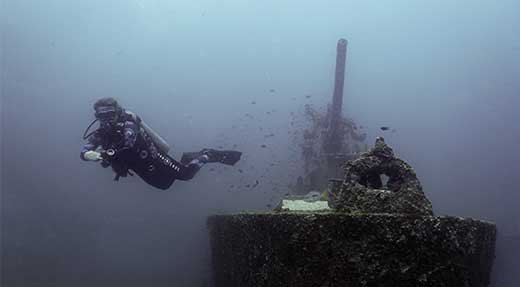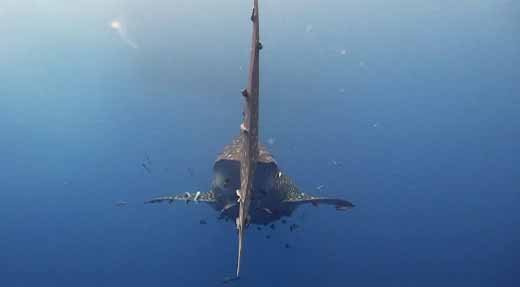Complete 5 Adventure Dives for the Advanced Open Water
I was addicted to scuba diving the moment I put my face in the water. The colours, the kaleidoscope of marine life that buzzed around me and it invited me to reach out, explore, discover more. As I practiced my mask and regulator clearing and fine tuning my elementary buoyancy skills I wondered what the next step was in my search for knowledge and adventure in the underwater world.
My enthusiastic dive instructor was quick to enlighten me that there was a simple solution to my natural inquisitiveness. The PADI Adventure dives and Advanced Open Water program are perfect for the underwater adventurer seeking new and exciting experiences.
How does the PADI Advanced Course Work?
Initially I was a bit confused about the way adventure dives integrated with the advanced course. PADI’s Adventure Diver Certification is for divers
who have completed 3 adventure dives.
PADI’s Advanced Course certification is granted to a diver who successfully completes 5 Adventure dives. The Adventure dives are introductions to individual specialty programs providing you with a taste of different areas of diving.
So if I was interested in wreck diving, following my open water course I could participate in a wreck adventure dive. It doesn’t teach me everything I need to know about wreck diving, but it provides the basics of that particular discipline.
And if I want to go on and complete the full 4 dive wreck specialty course, I would have already completed the first dive of that course.
Adventure dives help you have more fun scuba diving
To complete the PADI Advanced Open Water course I needed to complete 5 Adventure dives. So this would mean I would complete the first dive and get something of an introduction to 5 specialty areas. Another advantage of the advanced course is that you can choose the specialty area you want to explore.
There are a couple of compulsory modules. These include underwater navigation and the deep, but the other three were entirely up to me.
While completing the Open Water Course was a real thrill, I quickly realised that I had simply learned the basics.
That there was so much more to learn and so much experience to gain before I could feel totally confident in my skills and knowledge under the water.
Sure,I had learned the basics, but I understood that I needed far more practice with my buoyancy skills. I figured the Peak Performance Buoyancy was an ideal starting point to try and improve my comfort as a scuba diver.
Good buoyancy allows you to conserve energy, use less air, move gracefully, and when these things happen you see more. A calm, still diver will experience more than the average beginner as the comfort and poise shown whilst exploring the marine environment ensures fish and other cool stuff are not scared away.
Being able to ascend and descend, and control your position in the water column with ease improves your safety immensely, as it is during these times that accidents can happen.
The underwater world produces magic and beauty
Inquisitive by nature, I wanted to know more about the underwater world. The marine life that lived there, the turtles, and sharks and most of all I was hoping to see a whale shark. Naturally enough (no pun intended!) I chose the Underwater Naturalist dive. The underwater naturalist is not, as many people sometimes hypothesise, diving naked (although this has been done), it provides a greater insight into the marine ecosystem.
The underwater world is a myriad of colours, shapes and wonderful new creatures. The way things move and interact is vastly different from terrestrial realms, and the buoyancy properties of water reduce the dragging effects of gravity enabling some of the weirdest yet most amazing creatures to evolve and thrive.
Take coral for example. Coral is a tiny upside down jellyfish that learned, over hundreds of millions of years, to secure itself to the bottom, catch its own food and create a solid limestone skeleton! In addition, it developed a symbiotic relationship with an algae, zooxanthellae, which vastly increased its ability to feed through photosynthesis. These animals (yes they are animals!) are often only a few millimetres in diameter however they create structures that can be seen from space! It is this sort of magic I quickly grew to appreciate and one of the reasons I stayed diving for so many years.
Go Wreck diving as part of your advanced course
I completed the Wreck Adventure dive as my final requirement for the Advanced course. The idea of sunken ships has always fascinated me and many a diver for eons. Exploring this structure that, for all intents and purposes should not be sitting at the bottom of the sea. Koh Tao is ideally placed for wreck diving
with a couple of good wrecks at ideal recreational diving depths.
Wreck’s can be dangerous places. They exhibit challenges not often faced by normal, recreational diving. Enclosed spaces, dark rooms, entanglement risks…these all combine to make wreck diving an area that requires more training. For my first wreck dive we mapped the wreck and got a thorough orientation of the location as a reference for future forays.
The HTMS Sattakut is a decommissioned Thai Navy vessel over 50m long, and rising from a depth of 30m to the top of the wheelhouse at 18m. At such a size it justifies further exploration and the additional three dives of the Wreck Specialty course provided adequate grounding for this most exciting of undertakings.
Underwater navigation is one of the two compulsory elements
of the Advanced Open Water Course.
It is a crucial skill that helps on so many levels. By knowing where you are on a dive site you can reduce stress, which consequently reduces air consumption, and allows you to enjoy your dive in the knowledge that you are where you want to be. I always like coming to the surface knowing I don’t have far to go back to the boat. Hopefully I am right under it!
There are so many options to choose from with the adventure dives that go into making up the advanced course it becomes difficult to know what to opt for. I guess the best part is that you are free to do more than 5 adventure dives if you want. Or better still you can continue on to specific specialties that catapult your dive experience to a whole new level.
A World of Scuba Diving Adventures awaits you
Diver Propulsion Vehicle (DPV): This is an awesomely fun activity to act like James Bond underwater. You can travel a long way and maybe see areas of dive sites that you would never get to simply by swimming. I would love to see a whale shark one day whilst using a DPV. Being able to effortlessly cruise alongside it would be amazing.
Underwater photography: Taking good photos on land is hard enough, taking good photos underwater is almost impossible as a beginner. With so much going on – managing buoyancy, air and where you are underwater, trying to focus on a camera and keep it steady is super challenging. Add to that the changes in the distance light travels and the way colour operates underwater and it is a whole new experience altogether.
Fish Identification: If you are like me, ⦁ you’ll love fish. Learning what differentiates one from the other is not that difficult, and with a few key pointers you’ll start to know your wrasses from you parrotfish in no time.
Search ⦁ &⦁ Recovery: Learn how to find lost treasures, or simply something you have dropped over the side of the boat. This course was so useful, especially when my $1000 dive computer went missing and I used the skills from the search and recovery course to find it again.
Night diving: Diving at night is one of my favourite activities. The handheld flashlight enhances the colours that are often difficult to see during the day. Some fish sleep at night, while others use the cover of darkness to stalk prey.
The Deep Adventure dive is a part of your advanced course
The deep dive is the other compulsory element of the Open Water Course. It is required for a reason. Obviously with added depth comes added risks. These can be many and varied from air management to the increased risk of decompression sickness, but i discovered deep dives introduced me to a whole new world of colours and shapes.
We conducted our deep dive at Chumphon pinnacle which was out of this world amazing. Enormous schools of snapper and big eye trevally circled the large rock pinnacles that rose from the depths. In the midwater, planktivorous fusiliers darted between the shafts of sunlight that shone down through the clear blue waters.
The rock itself was covered in life. Different life from the corals of the shallows. At depth, with sunlight at a premium, different animals thrive. Soft corals and filter feeding sponges dominate the pock marked rock. Moray eels poke their heads out of holes whilst sea urchins hide amongst the crack and crevices. At depth we swam with bull sharks that visit during some of the cooler months. I am told bull sharks can be dangerous but these were nothing but friendly.
Whaleshark – the Largest Fish in the Sea
Deep diving brought in a whole new dimension to the diving experience opening up what appeared to be an entirely new realm. It was something unexpected but one i embraced with amazement and joy.
The greatest experience was no doubt being at around 25m depth and looking up to see the hulking silhouette of a whale shark cruising past the pinnacle.
As we ascended it turned in a wide sweeping arc like an enormous jetliner. Schools of remoras and trevally travelled in concert with the largest fish in the sea, like the contrails of those same airliners as they travel across the sky.
It was an experience I remember with much joy, and one I yearn to repeat somewhere, sometime.
© Crystal Dive Koh Tao











